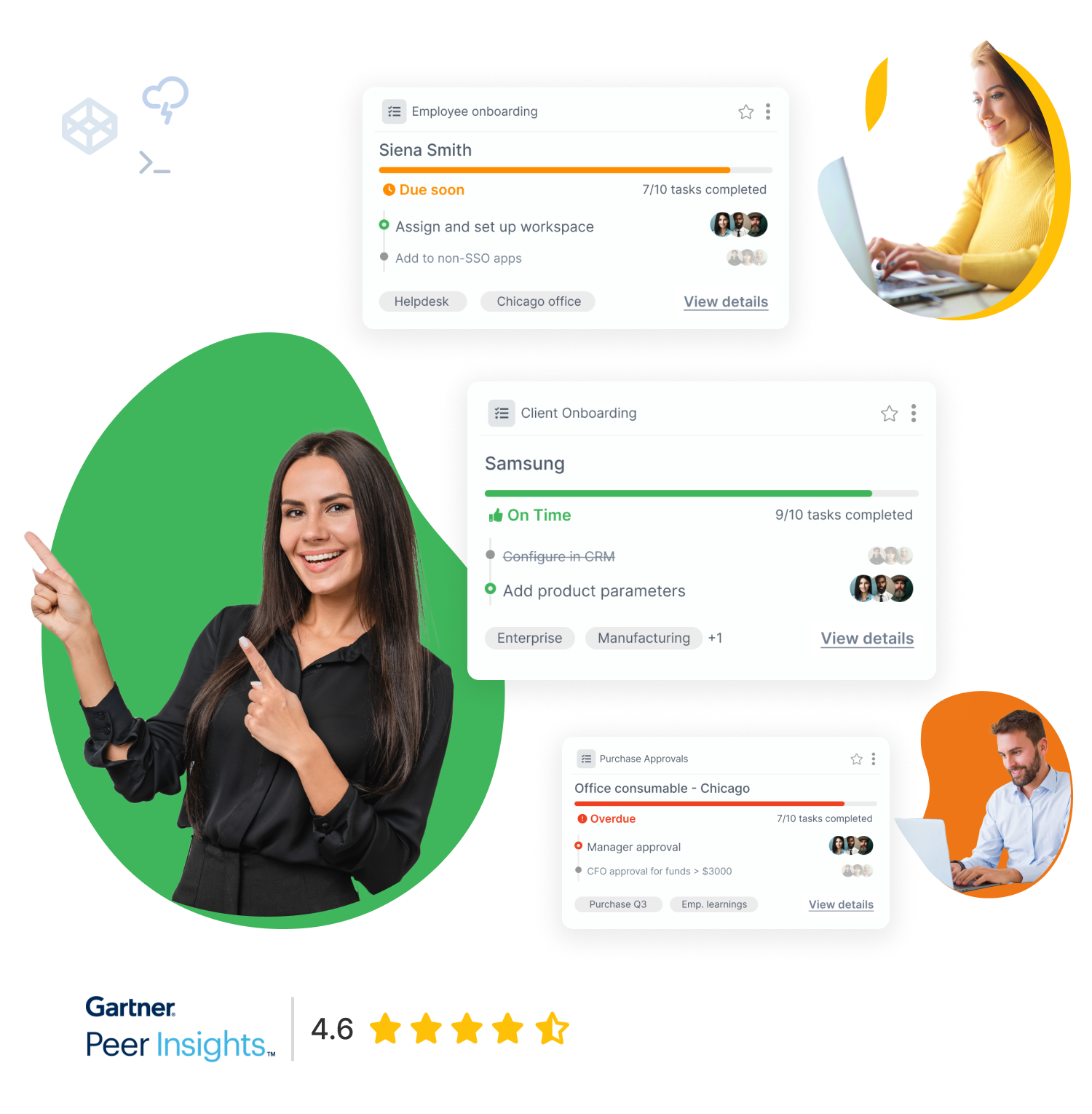Getting your employees off to the right start is crucial.
69% of your employees will be more likely to stay for 3 years or longer if they’ve experienced a positive employee onboarding process through effective employee onboarding software.Christine Marino
Source
Achieving that experience among your employees, of course, is a complex process. The first days on the job should in equal measure prefer new workers what they can expect during their workdays, and introduce them to both the working culture and individual team members. Only the right combination of tangibles and intangibles can reliably turn them into productive and happy employees at your company.
The importance and complexity of the process are exactly why increasingly, even smaller companies embrace strategic employee onboarding software. According to the Harvard Business Review, only 22% of companies don’t have any type of formal onboarding process in place.
Simply planning that process, of course, is not enough for success. Your company also needs the tools necessary to execute your onboarding strategy. Finding the right technology, for example, is paramount. To help in that regard, here are 5 features your employee onboarding software should possess.
A Multi-Dimensional Process
Regardless of what industry you operate in, your onboarding process is probably pretty complex. New employees have to become familiar with company policy, fill out benefits paperwork, and complete a variety of other tasks that are prerequisite to being and remaining in good standing.
At the same time, they also have to learn their tasks, ideally in a structured way. A simple automated sequence of emails will probably not be enough to help communicate all of these tasks and messages. Instead, you need software that addresses the multi-dimensional nature of the employee onboarding process in today’s environment.
What exactly that software looks like, of course, depends on your individual needs. It may consist of reminders to a number of stakeholders to send a personalized email or complete a phone call. Automated emails may also be part of the equation. Only the software that addresses each of your (and your new employees’) needs can help you reliably optimize your onboarding process.
Customizable Steps and Branches
Of course, addressing these needs goes beyond simply sending multiple types of messages. The multi-dimensional nature of the process also extends to accounting for the different needs of your various new types of employees.
As you can probably imagine, for example, new managers will need to go through a very different onboarding process than administrative assistants do. The messages they receive, and tasks they have to fulfill, should be optimized not just for your company, but also for the roles they’re about to fill within your organization.
And even within each role, differences may exist. For example, you may find that some managers need a more high-touch approach than others. The perfect candidate you just hired to head your finance unit, for example, may be open about not being as tech-savvy with filling out online documents. That candidate, then, may need a little more hand-holding than the new marketing director who spends his professional time online.
Ideally, your employee onboarding software should account for these differences. It should both allow you to set up a variety of branches based on employee roles, and the ability to customize the execution of each role for individual employees. The result will be a more personalized, and more successful, onboarding process.
Multi-User Access and Responsibilities
The onboarding process is likely owned and led by your human resources team. But will they be the only ones responsible for getting new employees off to the right start? The answer to that question is crucial in finding employee onboarding software that fits your needs.
If only one person within your HR department owns the entire process, finding software to fit your needs may be simple. But most likely, that will not be the case. Instead, you might have a benefits manager in charge of the paperwork in that area, a legal representative to go over the employees’ responsibilities and liabilities, and a team leader within the new worker’s department who is responsible for the task-oriented information.
The messages that each of these individuals sends should be different. And most importantly, not all of them will have the time to keep up with the onboarding requirements. Finding software that helps to set up different ‘owners’ for each step or branch, and sends them reminders to complete their tasks, can be a crucial help in optimizing your process.
Effective Deadline Setting and Tracking
Every employee onboarding process has some deadlines for your company to worry about. New employees need to enroll in their benefits packages within a given timeframe, an official contract may have to be signed, and a potential trial period may require additional paperwork before a temporary position is moved to permanent.
Honoring and keeping these deadlines will benefit everyone involved. That’s why companies can benefit from employee onboarding software that helps keep track of these deadlines and sends reminders to complete individual steps on an ongoing basis. The result will be a more efficient process that ensures everything gets done in time for the employee to transition into their new role as smoothly as possible.
Continuous Improvement Capabilities
No onboarding process is perfect. No matter how strategically you approach the subject, you will probably find some roadblocks and potential issues that can prevent your new employees from jumping on board as smoothly as possible. Your process should be designed with continuous improvement in mind, and finding the right software to enhance your capability in that area is key. Ideally, that means your employee onboarding software should include two features: feedback opportunities and analytics capabilities.
Giving everyone involved in the process the opportunity to offer feedback can gauge potential issues. Once more than one step owner or new employee notes the same thing, it may be time for a change. Through feedback, you can improve your process over time.
Feedback is a valuable qualitative improvement tool but may fail to catch some more systematic issues with your process. That’s why your software should also include a more structured analytics suite that allows you to track the process of each new employee through the workflow.
To stay with the above example, your analytics feature may find that new employees consistently miss the deadline for their benefits paperwork. Through feedback, you can then establish just why that is the case, and improve the process for future employees. Don’t ever rest on your laurels; instead, look to consistently updating and improving your employee onboarding to maximize its chances of retention success.
Finding the Right Software For Your Onboarding Needs
If you are looking to not just attract but also retain your most talented new employees, a strategic approach to the onboarding process is absolutely crucial. The software is not a solve-all that magically solves all of your onboarding needs. It does, however, provide the structure you need to put your strategy into action, and improve the experience for new workers.
Of course, you can only accomplish that goal if you find software that actually suits your onboarding needs. Ideally, your software should include all five of the above features. If it does, the result will be a smoother employee onboarding process that benefits everyone involved.
Related Questions
What is employee onboarding software?
About Employee Onboarding Software Employee onboarding software refers to a digital tool that helps companies welcome and train new hires. Basically, it’s like a friendly usher leading a new hire around to show them what they need to learn and do at their new job. It covers paperwork, training videos, team introductions and task checklists, all in one place, helping smooth and organize the laborious first few weeks of work.
What is the best onboarding software for small businesses?
Simple, affordable, easy to use The perfect onboarding software solution for small businesses is simple, cheap, and user-friendly. Tallyfy stands out for a few other reasons: It’s flexible, and users don’t need technical skills. Other worthy mentions are for easily integrating with payroll (Gusto) and from ease of use (BambooHR). The best answer is, of course, that it depends on what your needs, team size and budget are – but as a rule of thumb you’ll want to make sure that the company you’re signing up with has a free trial, and that they offer good customer support.
What are the 4 C’s of employee onboarding?
The 4 C’s of employee onboarding are Compliance, Clarification, Culture and Connection. Compliance includes all the rules and legal paperwork. Clarity gives employees a clear picture of what is expected in their line of work. Culture includes corporate values and behaviors. Connection allows new hires to bond with their new teammates. All this is something that good onboarding software should assist with.
How does employee onboarding software work?
Employee onboarding software develops a guided digital process for new hires. When someone new joins the company, the software knows to send welcome emails, assign training tasks or share essential documents. It monitors progress, sends reminders and enables managers to see how new employees are performing. It’s a really smart administrator, ensuring that nothing is left to the wayside.
What are the advantages of using employee onboarding software?
Onboarding software saves an enormous amount of time by automating monotonous tasks. It avoids paper work errors, guarantees uniform training and makes new hires feel welcomed and ready. The preponderance of evidence suggests that employers who use this software find that their new hires are productive sooner and are more likely to stick around. It also greatly simplifies remote onboarding, which is particularly relevant today.
How long should the employee onboarding process take?
The old wisdom was a week or two, the new is 90 days for full effectiveness of onboarding these days. Great onboarding software also makes the learning curve more manageable, so that new hires don’t feel overwhelming. It breaks the journey down into bite-sized portions and you can see how things are going over the long term (beyond just the first few days).
Can employee onboarding software help with remote workers?
Yes, remote teams can benefit the most from onboarding software. It provides them with a virtual welcome, makes remote workers feel like they are plugged into the company and that they have received all the training and information they need. That could mean virtual meet-and-greets, video training sessions and digital check-ins to maintain connectedness and support for employees working off-site.
What features should I look for in onboarding software?
Find a software that includes document management, automated workflows, progress tracking and simple communication. It should have the capability to link with your current HR systems, provide mobile access and be tailored to your company. The best products also leverage reporting features to enable you to iterate on your onboarding process over time.
How much does employee onboarding software cost?
Pricing varies by miles, from a few bucks per employee per month to enterprise solutions in the thousands. For small- to medium-sized businesses, the $5-20 per employee per month tier should provide plenty of solid choices. Most offer flexible pricing based on the size of a company and the features required, and even free versions for very small teams can be found.
Can onboarding software improve employee retention?
Studies have shown good onboarding can boost employee retention rates by 82%. Great onboarding software establishes that positive first impression, communicates expectations to your employee and helps them feel appreciated from day 1. It offers newcomers a guided and welcoming experience, so they can create better connections with their team and organization.

